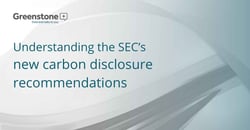Understanding the SEC’s new carbon disclosure recommendations
 In March 2022, the US Securities and Exchange Commission (SEC) released a new proposal for public companies to begin reporting their carbon emissions and reductions progress alongside their financial results.
In March 2022, the US Securities and Exchange Commission (SEC) released a new proposal for public companies to begin reporting their carbon emissions and reductions progress alongside their financial results.
These SEC rules aim to make corporate sustainability reporting more common, consistent, and standardised like financial accounting and reporting, similar to the recent EU Corporate Sustainability Reporting Directive (CSRD) in Europe. At Greenstone, we are keeping a close eye on the progress of the proposal and have put together a series of resources on what to look out for ahead of the final vote.
This blog covers who this proposal applies to, what it asks for, what the requirements for scope 3 are and how Greenstone’s software can help start preparations.
Who is affected by the proposal?
We expect the SEC's rules will apply to all publicly-listed companies with an existing SEC reporting requirement.
The initial focus will be on what the SEC defines as large accelerated filers, which are publicly traded companies with a market cap above $700 million.
The SEC also mentions smaller registrants in its proposal. Under Section 12(g) of the Exchange Act, the SEC's proposed climate disclosure requirements may also end up applying to a broader group of registrants, including:
- Any company with total assets in excess of $10 million and 500 or more record holders of a class of equity security, each measured at the end of its fiscal year
- Other SEC registrants
For large companies, the SEC's climate disclosure requirements begin in 2023. Smaller companies have until 2025 before they need to comply.
What is the proposal asking for?
Largely due to investors' requests, the SEC is requiring companies to disclose their greenhouse gas emissions and climate risks in a standardised way.
The main disclosure topics include:
- Climate-related risks (including risk identification/impact governance, oversight/risk management and mitigation)
- Greenhouse gas emissions
- Climate-related financial metrics
Much of the SEC’s proposal builds on the work of the Taskforce for Climate-related Financial Disclosures (TCFD), which already requires disclosures to ensure investors have full insight into the carbon and climate risks in their portfolios.
With this proposal, companies would need to submit the following alongside their financial disclosures in their annual reports:
- Disclosure of Scope 1 & 2 GHG emissions (i.e., direct emissions and those from purchasing electricity and heating/cooling) and calculation methodology.
- Disclosure of Scope 3 GHG emissions and calculation methodology, if material to the reporting company, or if the reporting company has set a public Scope 3 emissions target. Scope 3 is covered in the section below.
- Disclosure of both absolute emissions and emissions intensity factors across all relevant scopes. Emissions intensity can be defined as either emissions per unit of annual revenue or emissions per unit of production for the fiscal year, (i.e., dividing total emissions by a fixed business metric e.g. revenue).
- Alignment of emissions measurement with the standards and guidance established by the GHG Protocol.
- Alignment of emissions inventory with the reporting company’s fiscal year, and, if data is reasonably available, emissions should be reported for the same number of years as required for the income statement and cash flow statement.
- Third-party assurance of Scope 1 & 2 emissions (dependent on reporting company size)
- Disclosure of all public climate pledges or emissions targets, including:
- Target emissions boundary and time horizon
- How the reporting company intends to meet its targets
- Data to indicate whether the reporting company is making progress toward its target
- How progress has been achieved
- Disclosure related to the use of carbon offsets and/or renewable energy certificates, including quantity, type, certification, and other relevant characteristics. Emissions figures would also have to list any carbon credits separately so that investors can see total emissions in isolation. Any internal carbon price used and the logic used to calculate it.
- The compliance deadline would be between 2023 and 2025 depending on the size of the organisation (the table in the FAQ provides the timeframe)
What about Scope 3?
Companies will be required to include Scope 3 data if those emissions are deemed by investors to be “material”. While there’s no official guidance there yet, it’s expected that the largest filers will be covered.
While smaller companies may not have a direct requirement to report Scope 3 emissions, the SEC’s proposal includes a rule that states that if a company has a public emissions-reduction goal, you must disclose your plan and progress against that specific goal. If your public goal includes Scope 3 emissions, you must include Scope 3 progress in your SEC reports.
How Greenstone's solutions can support carbon disclosure for SEC
Greenstone’s suite of sustainability, supply chain and investor ESG software solutions provide an integrated approach to addressing the challenge of both climate risk as well as Scope 1,2 and 3 emissions calculation and reporting. Greenstone’s Frameworks module, part of its Enterprise sustainability reporting software, has a TCFD tool to enable users to monitor Management Information and collect, analyse and report site-level climate change risks and opportunities. This will likely be aligned with the new SEC reporting requirements.
Providing a central hub for the collection and aggregation of Scope 1, 2 and 3 data and across all 15 Scope 3 categories, Greenstone’s solutions support businesses on their climate reporting journey and will adapt as the SEC requirements come into fruition.
Learn more about SEC - Our 30-minute webinar helps companies understand the proposed rules and learn how to prepare their environmental data in accordance with the proposed legislation. Watch on demand below.
References
- https://www.paulweiss.com/media/3981948/a_guide_to_the_secs_proposed_climate_disclosure_requirements.pdf
- https://www.esgtoday.com/the-sec-unveils-long-awaited-proposed-climate-disclosure-rules
- https://www.pwc.com/us/en/services/esg/library/sec-climate-disclosures.htm
- https://dart.deloitte.com/USDART/home/publications/deloitte/heads-up/2022/sec-analysis-climate-disclosures











